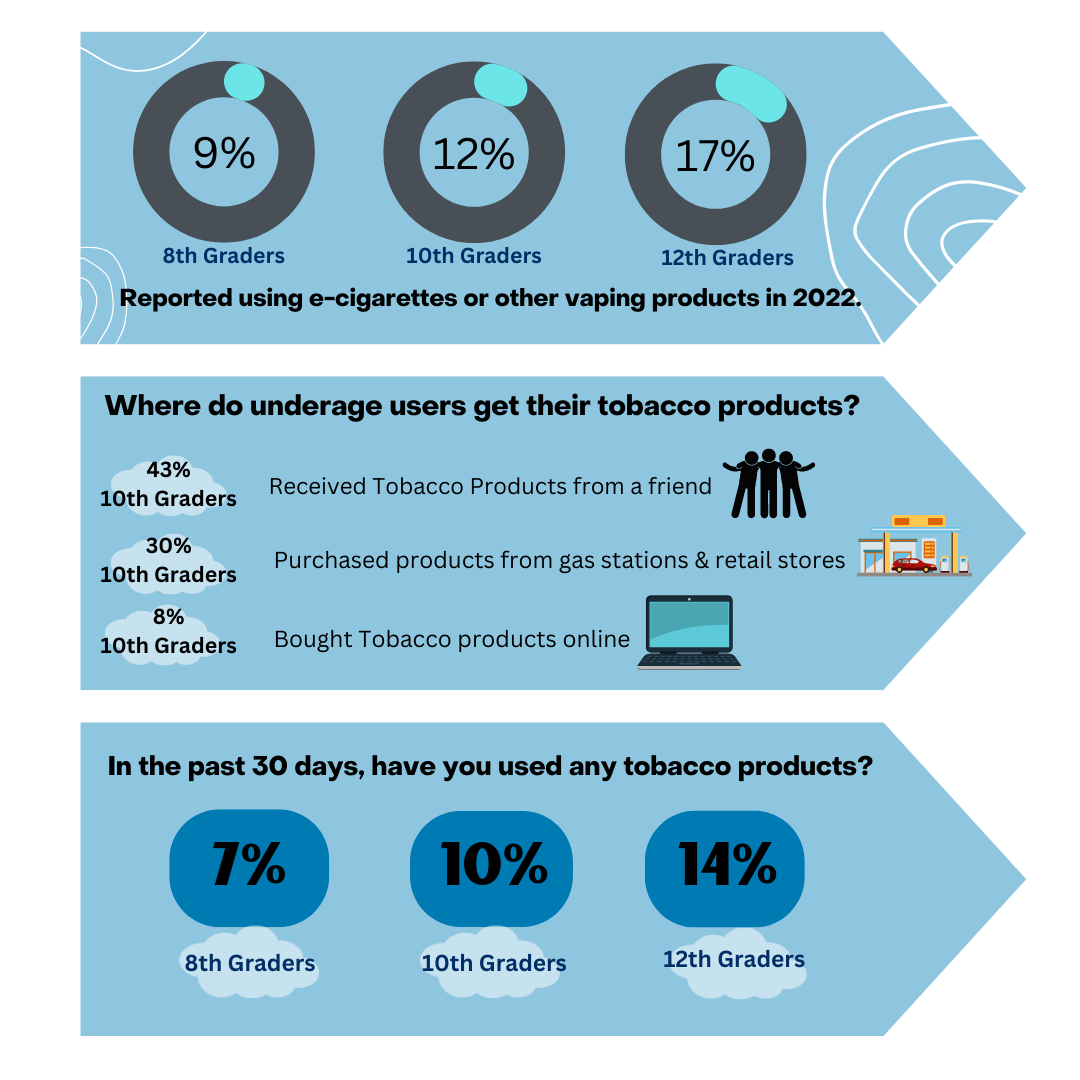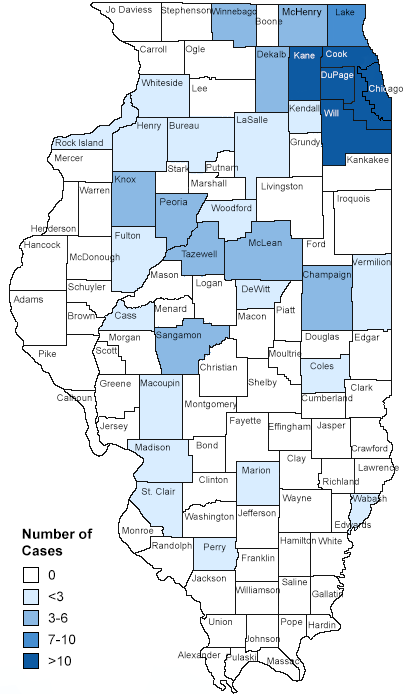(Image from The Surgeon General)
Devices
Vaping/e-cigarette devices come in a variety of shapes and sizes with several different names. Some look like regular cigarettes, but many resemble pens or USB flash drives, and are not recognized as tobacco products. Larger devices such as tank systems, or “mods," do not resemble other tobacco products.
Generally, a vaping/e-cigarette device consists of a:
- Mouthpiece
- Battery
- Cartridge for containing the e-liquid or e-juice
- Heating component for the device that is powered by a battery
When the device is used, the battery heats up the heating component, which turns the contents of the e-liquid into an aerosol that is inhaled into the lungs and then exhaled (Center on Addiction, 2019).

(Image from The CDC)
Nicotine and Electronic Cigarettes
E-cigarettes containing nicotine aren't considered safe for adolescents, young adults or pregnant women. Nicotine can harm brain development in children and young adults into their early 20s and is toxic to developing fetuses. Children and adults have also been poisoned by swallowing, breathing or absorbing e-cigarette liquid through their skin or eyes, according to the CDC.
The strength of an e-cigarette is determined by the amount of nicotine in the e-liquid and is expressed in milligrams per milliliter or as a percentage. However, studies have raised concerns that product labels don't always provide accurate information about nicotine content. Some pods contain a concentrated form of nicotine called nicotine salt.
A pod containing 5% nicotine salt may have as much as 30 to 50 milligrams of nicotine, the equivalent amount of nicotine delivered in one to three packs of cigarettes. According to the manufacturer, a single JUUL pod contains as much nicotine as a pack of 20 regular cigarettes.
In youth and adult nonsmokers, e-cigarette use poses the risk of a nicotine addiction. This could lead to long-term use of e-cigarettes, the effects of which aren't fully known, and to the use of traditional cigarettes (Mayo Clinic, 2019).

(Image from The Truth Initiative)
Youth E-Cigarette Use
Some of the main factors that contribute to the youth e-cigarette use epidemic are:
- The marketing of e-cigarette/vaping products
- The appealing flavors
- The addictive properties of nicotine
E-cigarettes have been primarily targeted toward youth/young adult use. Companies such as JUUL have been utilizing tactics such as using young adult actors, fun music, and colorful designs in their promotions, as well as utilizing social media platforms commonly used by youth and paying social media influencers to promote their product (Truth Initiative, 2019).
E-cigarette and vaping products can come in a variety of flavors. Popular flavors for youth use include:
- Mint
- Vanilla/Crème Brulee
- Mango/Other fruit flavors
- Menthol
These flavors make using the product more “fun" and are a main reason as to why the youth use the products. Most youth who use e-cigarettes do not consider themselves to be smokers. The nicotine that can be found in most of these products is what causes the youth to become addicted to e-cigarette use (American Lung Association, 2019).
Some health effects of nicotine to youth are:
- Harm to brain development
- Impairments to memory, attention, and learning
- Altering brain chemistry
- Can make youth more vulnerable to other drugs
- Nicotine poisoning (at high doses can lead to hospitalization or death)

Local Youth Data
The U.S. Surgeon General declared vaping an epidemic among youth in 2018. Beginning July 1, 2019, Illinois law prohibits the sale of tobacco products, including these products, to people younger than age 21. The following data on Kane County e-cigarette use among youth is from the 2022 Illinois Youth Survey:

Looking to Quit Vaping?
The Truth Initiative has created the first-of-its-kind text program for youth to quit vaping called This is Quitting.
Youth, or concerned parents of youth who vape, can text the line to receive information on how to quit vaping and set a quit date.
Text “DITCHJUUL" to 88709 for youth and young adults trying to quit e-cigarettes
Text “QUIT" to 202-899-7550 if you are a parent or other adult looking to help young people quit
https://truthinitiative.org/thisisquitting
The Illinois Tobacco Quitline now provides assistance with quitting vaping. Call now to create a quit plan and receive in-depth cessation counseling.
1-866-QUIT-YES
1-866-784-8937
https://quityes.org/
LOCAL HOSPITALS
If you interested in attending local e-cigarette and/or tobacco cessation programs, contact your local hospital to see what programs they have available.
Advocate Sherman Hospital - (847) 742-9800
AMITA Health Mercy Medical Center Aurora - (630) 859-2222
AMITA Health Saint Joseph Hospital Elgin - (847) 695-3200
Northwestern Medicine Delnor Hospital - (630) 208-3000
Rush Copley Medical Center - (630) 978-6200
Will E-Cigarettes Help Me Quit Smoking?
E-cigarettes aren't approved by the FDA as a quit aid. Studies to test whether e-cigarettes can help people stop using tobacco have had inconsistent results. Limited research suggests that using only e-cigarettes containing nicotine to quit smoking can be effective short term compared with using medicinal nicotine replacements, but there isn't enough evidence comparing the safety and effectiveness of using e-cigarettes to quit smoking and established evidence-based treatments.
E-cigarettes might be appropriate only in those unwilling to try evidence-based smoking cessation therapies or who haven't had success with such therapies. If you use e-cigarettes to quit smoking, remember that your goal is to completely quit using all tobacco products. Also, the dual use of e-cigarettes containing nicotine and traditional cigarettes is strongly discouraged.
If you're looking for help to stop smoking, there are several FDA-approved medications that have been shown to be safe and effective for this purpose. A combination of medication and counseling has been shown to work best (Mayo Clinic, 2019).
Lung Injury Related to Vaping & E-Cigarette Use
2019 Lung Injury in Illinois
Updated January 16, 2020 (IDPH, 2020)
*Case means evidence of respiratory illness, with no other cause identified, and report vaping in the last 90 days.
** Death included in the number of cases
In recent months the Centers for Disease Control and Prevention (CDC) has reported more than 1,000 cases of lung injury tied to vaping or e-cigarette use.
The CDC has created a term for the illnesses: e-cigarette, or vaping, product use associated lung injury (EVALI).

The CDC has identified vitamin E acetate as a chemical of concern among people with EVALI.
- Recent CDC laboratory test results of bronchoalveolar lavage (BAL) fluid samples from 29 patients submitted to CDC from 10 states found vitamin E acetate in all of the samples.
- Tetrahydrocannabinol (THC, the principal psychoactive component of cannabis) was identified in 82% of the samples.
- Nicotine was identified in 62% of the samples.
- Vitamin E acetate might be used as an additive, most notably as a thickening agent in THC-containing e-cigarette, or vaping, products.
- CDC recommends that people should not use THC-containing e-cigarette, or vaping, products, particularly from informal sources like friends, or family, or in-person or online dealers.
- While this investigation is ongoing, vitamin E acetate should not be added to e-cigarette, or vaping, products.
While it appears that vitamin E acetate is associated with EVALI, evidence is not yet sufficient to rule out contribution of other chemicals of concern to EVALI.
Many different substances and product sources are still under investigation, and it may be that there is more than one cause of this outbreak.
The only way to assure that you are not at risk while the investigation continues is to consider refraining from use of all e-cigarette, or vaping, products.What Is the Role of Kane County Health Department in the Investigation?
This is an ongoing investigation with suspect cases being reported to the health department from health care providers.
Suspect cases are interviewed to better understand their symptoms and progression of disease, as well as gain insight into their vaping habits such as type of product used,
frequency of use, type of device used and information on where product was purchased. Whenever possible, the product is given to the health department and this is passed on to labs for testing.
Kane County Tobacco Control Coalition
Would you like to join the Kane County Tobacco Control Coalition, need a presentation/speaker, or printed resources on vaping? Email us at: kanequits@countyofkane.gov
Is Your Business Interested in Becoming Vape-Free?
If you are a business looking to go vape-free, email us at: kanequits@countyofkane.gov
Additional Resources
Centers for Disease Control and Prevention - https://www.cdc.gov/tobacco/basic_information/e-cigarettes/severe-lung-disease.html
Illinois Department of Public Health – http://www.dph.illinois.gov/topics-services/prevention-wellness/tobacco/e-cigarettes-and-vapes
Scholastic - http://www.scholastic.com/youthvapingrisks
SurgeonGeneral.gov - https://e-cigarettes.surgeongeneral.gov
Truth Initiative - https://truthinitiative.org/research-resources/emerging-tobacco-products/e-cigarettes-facts-stats-and-regulations